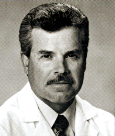Giving Cancer Patients a Whole New Look
 At his home in Fresno, Texas, A. J. Berg often takes a ride on his Harley
Davidson.
At his home in Fresno, Texas, A. J. Berg often takes a ride on his Harley
Davidson. "It's our job to restore form, contour and function of the specific
part of the body that was removed so people can feel better about themselves."
- Dr. Geoffrey L. Robb
"It's our job to restore form, contour and function of the specific
part of the body that was removed so people can feel better about themselves."
- Dr. Geoffrey L. Robb